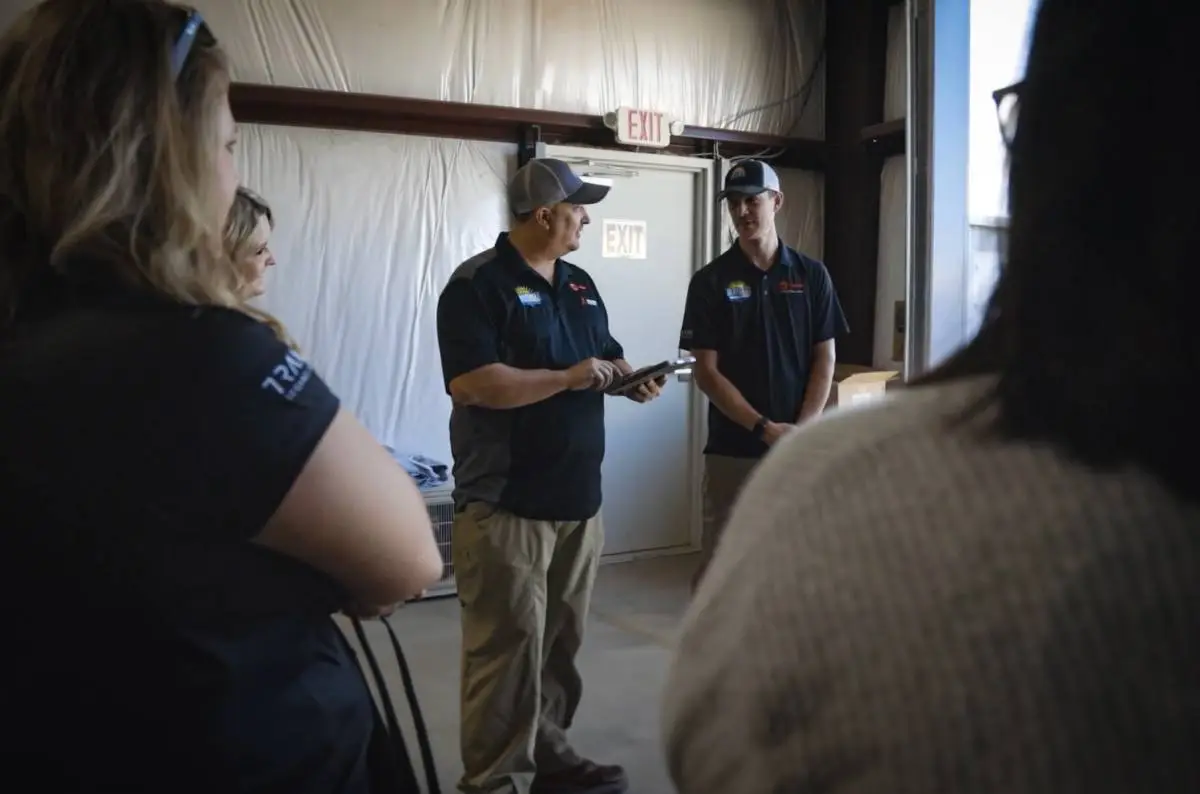
Making money in the service business is a complicated thing. Sure, you have to book enough jobs, but your business also needs to make certain that it is making enough on each job to justify the work. That is where Housecall Pro can provide assistance.
If you want to know how to find the total cost of a job, there is one helpful tool. A job costing formula is essential and can help provide a clear picture of what the job will cost to perform. Even more importantly, it will make quoting the job to clients easier, ensuring better financial decisions for the bottom line of the business.
What is Job Costing?
Before we jump into finding a job costing formula, it helps to know what job costing is in the first place. To put it simply, job costing is a method of determining the total direct cost of performing that job, service, or project.
Job costing is critical because it allows businesses to determine what the profitability is of each job. Moreover, it allows businesses to manage project costs, estimate the cost of new projects, and determine whether jobs are worth taking on in the first place.
Job costing takes several factors into consideration. Material costs, labor costs, and any other expenses that are directly related to the job are considered. It quickly becomes apparent which jobs are more or less profitable than others and takes all of the guesswork out of the process. For service businesses, job costing is an essential part of day-to-day life.
Job Costing vs. Process Costing: What’s the Difference?
There are two terms that you will hear when it comes to determining the overall cost of a job. That said, don’t get confused when it comes to job costing vs. process costing. They are distinctly different, but both are essential to the bottom line of the business.
Though the two sound similar, one looks at the cost of performing the job while the other looks at setting prices for upcoming jobs. They go hand in hand, and both are critical to the business. Let’s take a look at each of them to see how they fit into the process.
Job Costing
Job costing is about looking at the final costs of a completed job. After all, how can you set a price for the customer if you don’t know how to find the total job cost? Costs for businesses – also known as overhead – change all the time, so having a regular job costing process ensures that there are no gaps in the process.
Job costing is done by determining the expected material costs, labor costs, and any additional costs like specialized tools or personal protection equipment (PPE). When everything necessary to the job has been applied, process costing can be applied.
Process Costing
Process/service costing is essentially how the business sets its prices. Though it may seem like these prices are pulled out of thin air to the consumer, they are carefully formulated to ensure profitability without gouging the customer.
In order to determine the price that should be set, businesses account for expected material, expected labor, and how much profit is desired. A good place to be is in the 15-20% profit range but many businesses allow for far less out of fear of losing business. But profit margins are a whole other topic for another time.
Why Should You Use Job Costing?
Why does a service business need to use job costing? It is one of the most useful tools for any business, especially when it comes to understanding how to price jobs, the true cost of the services being provided, and what kind of profit comes from each service/job.
Accurate job costing is critical for any business. Without it – or without being accurate – it is possible to undercharge for that work. While that might not sound like a big deal from time to time, everything adds up. Undercharge enough times and the business will hurt because of it.
Just as importantly, keeping track of job costs provides a reference database. While regular jobs may become second nature to price, what about the niche jobs? Keeping a database will provide a wealth of information to ensure that every job, common or rare, is accurately priced.
Above all else, job costing is crucial for budgeting, forecasting finances for the year, and even filing taxes. Being loose with job costing can be potentially devastating for the bottom line of the business. Stay on top of job costing by learning how to find total job cost accurately.
What is a Job Costing Formula?
If it sounds difficult to figure out how to find the total job cost, don’t worry. As it turns out, there is a job costing formula that is extremely helpful in situations like this. The equation is relatively simple at its core, and it looks something like this:
Materials + Applied Overhead + Labor = Total Job Cost
Each of those categories can expand and become a bit more comprehensive depending on the size of the business and scope of the job. But keeping things in those categories and adding them all together will help create a consistent total job cost that is accurate and ensures that there are no gaps between costs and payments.
To expand a bit, labor has its own equation to follow. In order to determine the cost of labor on a job, multiply the number of working days by the daily pay rate by the number of workers. Labor is one of the biggest costs of any job, so getting it right is perhaps the most important aspect of the job costing formula.
When to Use a Job Costing Formula
So, when do you apply the job costing formula? Some businesses will wait until the end of the job to figure out actual costs because estimates can be highly inaccurate. When all of the costs have been accounted for, they then invoice the customer for the work done. That said, it can be a slippery slope and things can fall through.
In order to get an accurate job cost, it must be done throughout the life of the project. Costs and demands change, so having real-time costs available is critical. It will allow for adjustments and help to spot issues as things unfold. This helps keep any unforeseen costs down that could potentially eat into the profitability of the job.
Another reason to keep your job costing current throughout the project is that it can help ensure that overhead costs are spent over a specific period of time. Profitability of a job can take a hit for any number of reasons, so having a job costing formula that can be used throughout the course of a project becomes arguably the most important tool there is.
How to Use a Job Costing Formula
If you still aren’t totally clear with how to use a job costing formula, never fear. We have a step-by-step guide that will help you create the most accurate job costing formula possible. Read on to ensure that you are calculating costs properly and maximizing the profitability of each job in the process.
Calculate Labor Costs
Start by calculating your labor costs. This refers to the salaries or wages that employees working directly on the job earn. To calculate that cost, we need to know the wages of each worker and the total labor hours worked. This can be done in timesheet software to make things easier. Here’s the formula:
(Hours worked by Employee 1 x Wage Rate of Employee 1) + (Hours worked by Employee 2 x Wage Rate of Employee 2) = Direct Labor Cost
To make it simpler, let’s say that you have two guys on the job. The first worker works 10 hours at a rate of $20, while the second worker comes in at $18 an hour for 8 hours. The calculation would look like this:
(10hrs x $20) + (8hrs x $18) = $200 + $144 = $344
In this example, the direct labor cost would be $344 for that job.
Add Material Costs and Expenses
Material includes any and all materials that are required to complete the job. Typically, that includes wood, metal, drywall, insulation, etc. Additional expenses include equipment purchased for the job or expenses that came up while completing it (fuel, cleaning supplies, or protective equipment).
Determine Overhead Costs
The last step in the formula is to determine overhead costs. That includes everyday expenses like office supplies, rent, utilities, administration staff labor, equipment upkeep, and more. They might not be attributed to any specific job but are necessary to keep the business running.
One way is to take your monthly overhead costs and divide them by the number of billable hours per month. For the most part, small businesses have a standard overhead fee (roughly 10-20%) that is applied to each job.
Calculate Total Cost per Job and Profitability
Finally, add everything up to determine the total cost of the job. In order to determine the profitability of the job, take your total revenue and subtract the cost of the job. If you are coming up with a negative profit, it’s time to adjust your prices.
Get In Touch: 858-842-5746
Let us earn your trust
On average, Pros increase monthly revenue generated through Housecall Pro by 35% after their first year.
See plan options and feature breakdown on our pricing page.
Service Business Job Costing Examples
What better way to see how the job costing formula works than with a direct example? In the service industry, there are plenty of situations where this kind of information can be helpful. For electricians, HVAC technicians, cleaning services, plumbers, and more, job costing is part of daily life.
Let’s say that a woodworker is taking on his first job of the year making a custom piece of furniture. The woodworker is the only employee of the business, so that narrows things down. Estimated overhead for the year is $40,000, and the estimated activity hours are 2,400. That would put him at $16.67 for each hour of direct labor.
After tracking the cost of materials (call it $500 for metal, wood, and other supplies), the woodworker determines that it will take 25 hours to complete. The overhead would be 25 hours x $16.67 ($416.66). If the woodworker charges a rate of $30 per hour, the direct labor cost will be $750 (25 x 30). Materials + labor + overhead = $1,666.66 for the total cost of the job, which is what will be quoted to the customer.
Why Use Job Costing Software for Your Business?
To make life easier, job costing software is key. Instead of having to manually calculate each cost, you can quickly plug in the numbers and determine accurately what it will cost. Check out the major benefits of having job costing software at your disposal.
Accurate
Accuracy is the single most important part of job costing. If things aren’t accurate, it could lead to lower profitability, which means that the business isn’t making as much as it could or should. Do that enough times and it begins to have a major impact on the business.
Job costing software ensures that each job is properly priced out. Human error is taken out of the equation, ensuring that each job is properly priced out and quoted. In the end, it ensures fewer gaps in the business and potential issues for the client.
Historical Data
“Those who do not learn from history are doomed to repeat it.” Using job costing software, your business can have access to any job it has ever priced. Though regular jobs may become relatively easy to predict, niche jobs present another challenge.
By having historical data to access, those niche jobs can be referenced at any time. Quickly price out a job that was done once years ago without having to rack your brain figuring out what the costs and profitability were.
Automated Process
The last reason to have job costing software is because it will free up man hours. Doing anything as a manual process means that someone has to actually do it. That can equate to a lot of time and money spent on a process that could be automated.
Having the right software will ensure that everything is done in a timely manner without having to sacrifice manpower. That time and effort can go to other areas of the business, creating a more effective and efficient business model.
Grow Your Business with Housecall Pro’s Job Costing Software
Housecall Pro is here to help and a free 14-day trial of our home service business software can help you become a job costing expert. Profitability is the key to any effective business and there is often little room for error. Utilizing our software, job costing can become so much easier.






